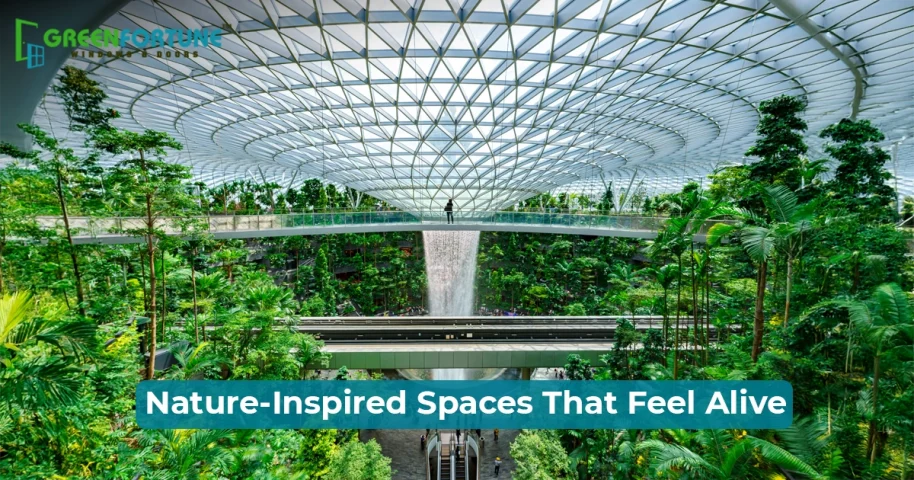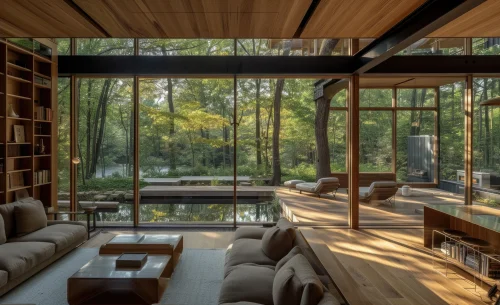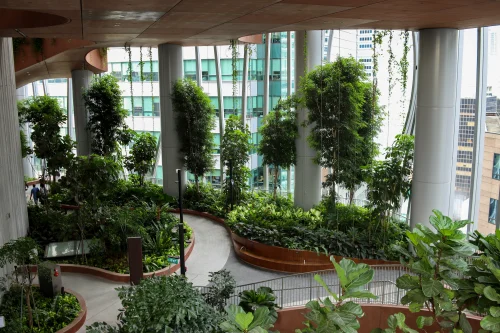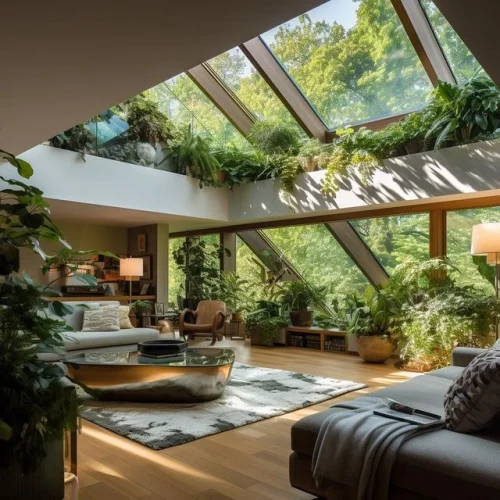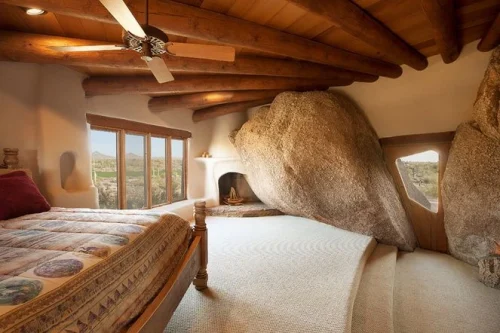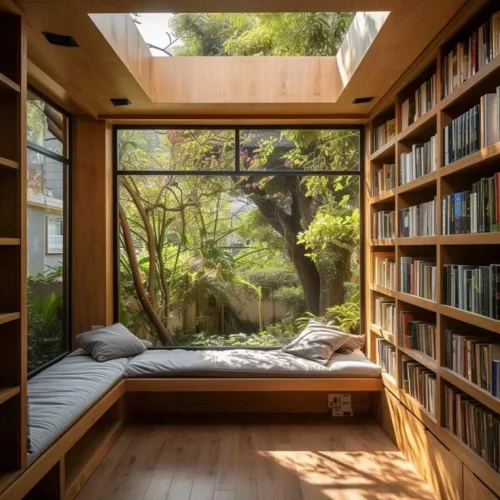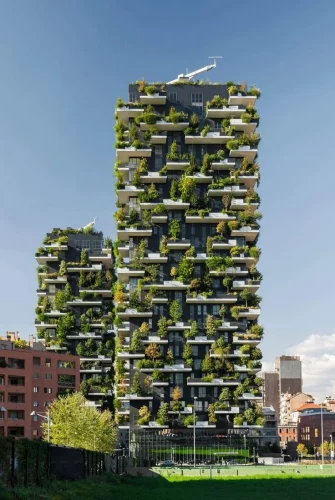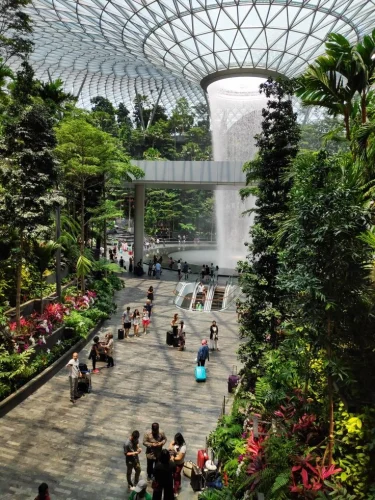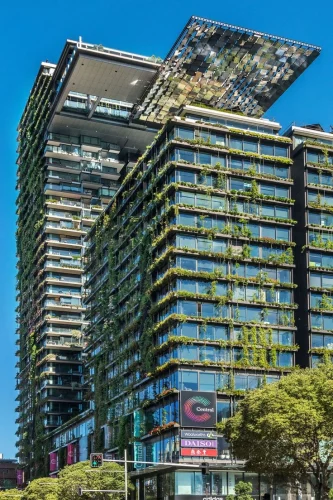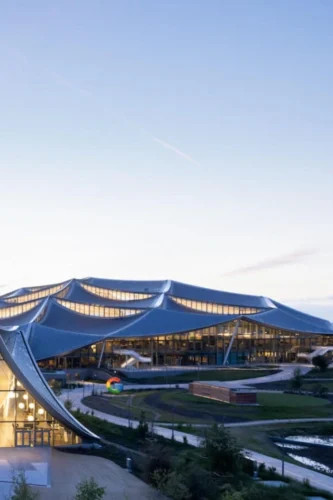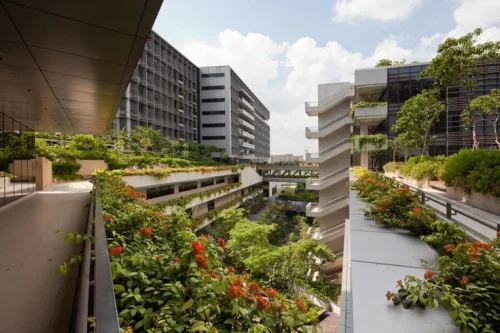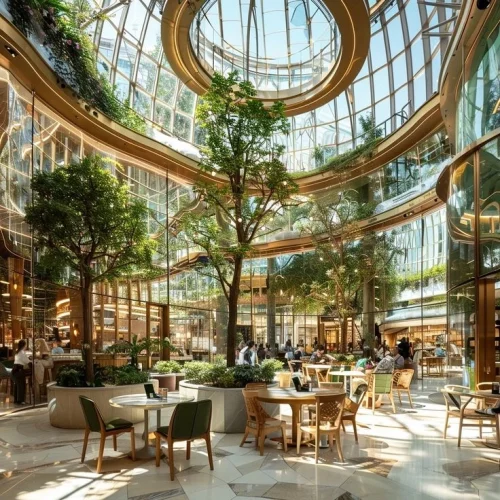
Home Celebrity Styles: Inside 6 Famous Star Homes
May 14, 2025
Green Celebrity Homes: Sustainable Style of the Rich and Famous
May 14, 2025We spend 90% of our time indoors, surrounded by four walls, screens, and artificial lights. Whether it’s at home or work, it’s the same story. Slowly, we’ve pulled ourselves away from nature. Mentally, physically, and emotionally.
Once in a while, we run off to the hills, sit by the sea, or walk through a quiet forest and think, “I wish I could live like this every day.”
But what if we told you that you don’t have to escape the city to feel that? That you can bring nature into your home, your office, your own building? Sounds unreal, right?
That’s exactly what biophilic architecture design does. Let’s learn more about it.
Also read: Best balcony designs to maximise fresh air and natural light
First Things First, What’s Biophilic Architecture?
Biophilic architecture is a way of designing buildings that helps us feel closer to nature.
It brings sunlight, plants, fresh air, water, and natural materials into our spaces. It helps you feel more alive, more focused, and more at peace, right where you are.
Is Biophilic Architecture Design And Green Architecture The Same?
No. Both may often go hand-in-hand, but they are NOT the same.
Green architecture is more about saving energy and protecting the environment, whereas biophilic architecture is about building space that feels close to nature.
Why Do We Need Biophilic Architecture Design Today?
Living in the cities, we are more digitally connected and mentally drained. We have time only to stare at the images of nature. And slowly, that disconnect starts to show up, in our bodies, in our minds, in our mood.
- We feel more anxious, tired and uninterested
- Offices see drops in productivity and attention
- Hospitals find patients recover slower in artificial environments
This is exactly why biophilic design matters now more than ever. It brings a bit of balance back. It helps us breathe easier, think better, heal faster, and feel more at home, even in the middle of a busy city.
Modern biophilic architecture helps,
- Reduce stress
- Improve productivity
- Boost mental clarity
- Improve air quality
- Supports sleep and well-being
Also read: How biophilic design helps improve mental health?
14 Biophilic Architecture Design Patterns
The biophilic architecture elements, developed by Terrapin Bright Green, are the most detailed framework for biophilic design. Let’s divide the patterns into three categories.
1. Direct Experience of Nature
Nature you can physically see, touch, or feel.
1). Natural light- Through skylights, wide windows, or glass roofs that fill your space with sunlight.
2). Airflow- Cross ventilation, jaali walls, ventilators, or open balconies that let air move freely.
3). Plants- Indoor greens, balcony gardens, or open courtyards that bring life into your home.
4). Water- Small fountains, reflective pools, rain chains, or even the sound of falling water.
5). Natural sounds- Birds chirping, rustling leaves, or water flowing in the background.
2. Indirect Experience of Nature
Nature represented through design and materials.
6). Natural materials- Use of wood, mud, lime, stone, cane, or clay in furniture and finishes.
7). Textures and patterns- Bark-like finishes, leaf shapes, wave forms, or nature-inspired carvings.
8). Earthy colours- Shades like terracotta, forest green, mud brown, or sand beige that feel grounded.
9). Organic shapes- Curved walls, rounded furniture, arches, or sloped roofs that mimic natural forms.
10). Natural lighting changes- Spaces where light and shadow shift through the day, creating a natural rhythm.
3. Experience of Space and Place
How the space flows and makes us feel.
11). Refuge- A quiet, cosy corner for reading or resting, often with a view or natural cover.
12). Mystery- Curved hallways, layered views, or entrances that slowly reveal what’s ahead.
13). Temporal change- The feel of a space changing with time, like how light or wind moves through it.
14). Sense of place- Designs that reflect the local culture, landscape, and climate, making the space feel rooted and meaningful.
Also read: Vertical garden plants for your home
Biophilic Architecture Designs Around The World
Take a look at the finest examples of biophilic architecture designs.
1. Bosco Verticle, Milan
2. Jewel Changi Airport, Singapore
3. One Central Park, Sydney
4. Google Bay View Campus, USA
5. Khoo Tech Puat Hospital, Singapore
How To Incorporate Biophilic Design In Your Home?
To make your home feel more connected to nature, start by making a few simple changes that can help you feel calmer, fresher, and more relaxed every day.
- Let sunlight into your rooms. Don’t use heavy curtains for your windows, and try light wall colours that make the room feel brighter.
- Let fresh air move through your home. Open windows on both sides of the room so the breeze can pass easily.
- Keep some plants inside. Start with simple ones like money plant, peace lily, or pothos. They’re easy to care for and make the room feel fresh.
- Use natural things like cotton, jute, bamboo, or wood in your furniture, rugs, or curtains.
- If you can, place your windows and doors where you can see outside or feel the wind coming in.
Related article: Top 5 ideas to integrate biophilic design in your home
If you're planning to change your windows and doors, go for something that works with nature. At GreenFortune, our uPVC windows and doors are made to let in more light and air, reduce outside noise, and keep your home comfortable in every season.
Final Takeaway
Biophilic architecture design isn’t a luxury. It’s more of a need. It’s not about doing more. It’s about doing things that feel right. A little sunlight, some fresh air, and a few natural touches can completely change how a space feels. And once you feel that difference, there’s no going back.
FAQs
1). What are the 5 senses of biophilic design?
Biophilic design connects with your five senses- sight, sound, smell, touch, and feeling. You see natural things like plants and sunlight, hear soft sounds like water or birds, smell fresh air, touch real materials, and feel peaceful in the space.
2). What are biophilic colours?
Biophilic colours are shades that remind us of nature. These include greens like leaves, browns like soil or wood, blues like the sky, and soft tones like beige, clay, or stone. They feel calm and natural.
3). What materials are used in biophilic architecture?
Biophilic architecture uses materials found in nature. These include wood, stone, mud, lime, bamboo, clay, and cane. They are often used for walls, floors, furniture, or ceilings to make the space feel real and grounded.







